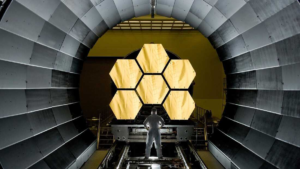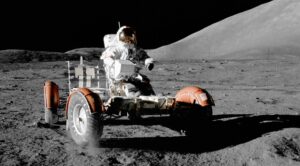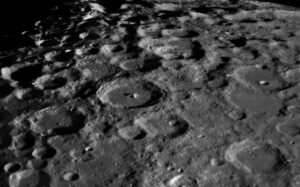
The JWST Spacecraft Bus Making The Mission Possible
The James Webb Space Telescope is set to be one of the most impressive and complex pieces of equipment ever sent into space. If successful this large list of instruments and components will look into the universe’s past and discover incredible things. However, with so many interesting parts of the telescope, vital sections such as the spacecraft bus can often be ignored.
The spacecraft bus of Webb provides many of the necessary support functions for the operation of the telescope. This includes vital features such as electrical power, attitude control, communication, propulsion, and more. All of which combine into the most advanced telescope ever sent into space. In addition, each feature is necessary if the JWST wants to capture and send back any information it gathers.
With the massive hexagon mirrors and unique features such as folding, it can be easy to ignore the other sections of the James Webb Space Telescope. In reality these hidden sections house countless amounts of advanced and important technology each serving a specific purpose. They are often just as interesting if not more than other features of Webb.
What Is A Spacecraft Bus?

A satellite or spacecraft bus is the infrastructure of the spacecraft. It usually provides important and necessary features for the main equipment it’s attached to. In relation to the James Webb Space Telescope, the spacecraft bus is the large box positioned underneath the main telescope. When taking a more detailed look at the JWST, you will first find the different goals and purposes of the next-generation telescope. From here you will start to see the different pieces of equipment in place to facilitate and help the telescope complete the different goals.
For example, this could be the primary mirror. Here you have 18 separate hexagon-shaped segments aligned perfectly to gather as much light as possible and reflect it extremely precisely. Another example could be the massive sun shield positioned behind the main telescope of Webb. After a lengthy deployment, it shields the telescope from any light coming from the Sun, Earth, Moon, etc. While these components of the JWST are very interesting and prominent, there is a long list of hidden features in other aspects of Webb such as the spacecraft bus that are necessary as well. Here I will go more in-depth into these somewhat hidden features that are just as important as the primary mirrors and sunshield.
JWST Spacecraft Bus Features

Electrical Power – The first feature of the spacecraft bus that is very important to the operation of Webb is the electrical power subsystem. This system converts sunlight shining on the solar array panels into the power needed to operate the other subsystems within the bus. In addition, it also powers the Science Instrument Payload. These solar panels are positioned underneath the telescope and sun shield ensuring they get access to a lot of light. Specifically, the raw power is fed to the SAR which consists of four redundant buck converters each operating with a maximum power point tracking algorithm. The next features of the spacecraft bus I highlight provide different specific needs of the telescope and need this subsystem to keep them running.
Attitude Control – The next necessary feature I want to highlight is the attitude control subsystem. This subsystem senses the orientation of the James Webb Space Telescope and ensures it stays in a stable orbit. It also provides the coarse pointing of the JWST to the area on the sky that the Science Instruments want to observe. These movements will need to happen quite often and are necessary for different tasks such as changing where exactly the telescope will be looking.
This system uses a large host of equipment to help control Webb including sun sensors, star trackers, and gyroscopes to sense the orientation along with moving it. It also uses reaction wheels and or thrusters to apply force or torque to the observatory for pointing control or maneuvers. Each of these has a specific purpose within the spacecraft bus. The reaction wheels help control torques needed to maintain attitude as well as to slew. The star trackers on the other hand provide stellar inertial attitude reference for 3-axis coarse pointing control. These all work together in a subsystem that is necessary for the success of Webb.
Communication – Another component within the spacecraft bus is the communication subsystem along with the command and data handling system. The communication subsystem is the ears and mouth of Webb. It receives instructions from the Operations Control Center and sends the science and status data back. All of these communications are routed through NASA’s Deep Space Network consisting of 3 ground stations in Australia, Spain, and the United States.
The JWST has multiple high-gain antennas mounted on a common articulated platform in order to send the necessary data back and forth. The other important feature is the command and data handling system. This system which is also called the C&DH is the brain of the spacecraft bus. This system has a computer, with the Command Telemetry Processor or CTP that takes in different commands from the Communications System and directs them to the correct recipient. It also has a memory and data storage device for Webb. Specifically, it contains the Solid State Recorder or SSR. Lastly, the CTP helps control the interaction between the various Science Instruments, the SSR, and the Communications System. Without any of this equipment, the James Webb Space Telescope would be floating around without a purpose.
Propulsion – The final piece of equipment within the spacecraft bus playing a big role is the propulsion system. This contains the fuel tanks and rockets that are fired to stay in the correct orbit. Webb has two different types of rocket thrusters. One is called the Secondary Combustion Augmented Thrusters or SCAT. These are used for orbit correction such as changes in velocity and orbit station-keeping. The James Webb Space Telescope has two pairs of them for redundancy.
They use a mix of hydrazine and dinitrogen tetroxide as fuel and oxidizer, which makes SCAT what engineers call a bi-propellant thruster. Taking a look at the other kind of thruster on the JWST, it’s called an MRE-1, or monopropellant rocket engine. This is due to the fact that it only uses hydrazine. In total there are eight of these engines on Webb. These are used for attitude control and momentum unloading of the reaction wheels. In addition, these engines are mounted and oriented so that torque can be applied in roll, pitch, or yaw control axes. For momentum unloads, these same thrusters are fired so that the applied torque provides the desired change in the angular momentum of the reaction wheels.
Conclusion
If successful, the James Webb Space Telescope will reveal new information about the history of our universe and much more. In order to complete such a challenging task, the JWST is comprised of many different parts and components throughout the entire telescope. While a lot of attention is usually surrounding the main mirror or sun shield, other aspects such as the spacecraft bus are just as important. The spacecraft bus holds many vital systems including electrical power, attitude control, communication, propulsion, and more. All of which work together to ensure Webb is fully capable of every task at hand. After launch, the JWST still has a long journey ahead of it prior to any successful information being provided. We will have to hope for its success and see the impact it has on the future of the space industry and more.



